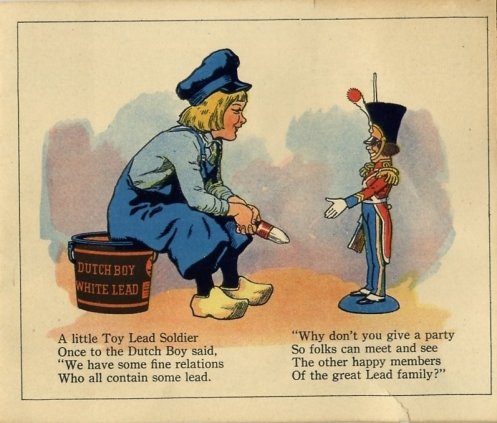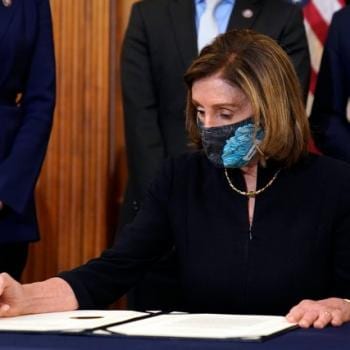In an era when the only question at a Republican debate is how far the candidates will go in their talk of gutting the Environmental Protection Agency—Trump has proposed eliminating it altogether—it may be worth taking some time to look back at the state of our environment before the creation of said agency. I’m going to look at specific products—namely, DDT and lead—and then turn to the quality of our air and water. I suspect that many of us today are less informed than we should be about the importance of 1970s-era environmental reforms—reforms we still need.
Check out this DDT advertisement from Time Magazine in 1947:
And check out this ad for DDT-laced children’s wallpaper:

DDT (dichloro-diphenyl-trichloroethane) was developed as the first of the modern synthetic insecticides in the 1940s. It was initially used with great effect to combat malaria, typhus, and the other insect-borne human diseases among both military and civilian populations. It also was effective for insect control in crop and livestock production, institutions, homes, and gardens. DDT’s quick success as a pesticide and broad use in the United States and other countries led to the development of resistance by many insect pest species.
And indeed, look at this image:

DDT was sprayed throughout neighborhoods and over pools and beaches. Children sometimes ran behind the trucks, frolicking in the clouds of spray. But soon, the problems became evident, as DDT took its toll on the natural wildlife and the birds began to die. Every time I hear a songbird near my home, I am grateful that our government took notice and acted to protect these populations.
The U.S. Department of Agriculture, the federal agency with responsibility for regulating pesticides before the formation of the U.S. Environmental Protection Agency in 1970, began regulatory actions in the late 1950s and 1960s to prohibit many of DDT’s uses because of mounting evidence of the pesticide’s declining benefits and environmental and toxicological effects. The publication in 1962 of Rachel Carson’s Silent Spring stimulated widespread public concern over the dangers of improper pesticide use and the need for better pesticide controls.
In 1972, EPA issued a cancellation order for DDT based on its adverse environmental effects, such as those to wildlife, as well as its potential human health risks. Since then, studies have continued, and a relationship between DDT exposure and reproductive effects in humans is suspected, based on studies in animals. In addition, some animals exposed to DDT in studies developed liver tumors. As a result, today, DDT is classified as a probable human carcinogen by U.S. and international authorities.
As you may note, DDT isn’t just bad for wildlife, it’s also bad for humans. But lest anyone suggest that because the primary harm DDT does is to birds and other wildlife and not to humans, let’s change topic to something slightly more personal.
Check out this ad from 1923:
Yes, really. Lead was advertised as good for children and was regularly included in paints and children’s toys.


Lead is a neurotoxin (thank you Neil DeGrasse Tyson). According to the EPA:
Lead can affect almost every organ and system in your body. Children six years old and younger are most susceptible to the effects of lead.
Children
Even low levels of lead in the blood of children can result in:
- Behavior and learning problems
- Lower IQ and Hyperactivity
- Slowed growth
- Hearing Problems
- Anemia
In rare cases, ingestion of lead can cause seizures, coma and even death.
The problem wasn’t just children’s toys and paint, it was also leaded gasoline. Lead was banned from paint in 1978. The level of lead allowed in gasoline began being controlled in 1973, and lead was ultimately phased out of gasoline entirely. In fact, some have argued that removing lead from the environment may have contributed to the reduction in crime we’ve seen over the past several decades. And who exactly do you think did this banning? The U.S. Consumer Product Safety Commission and the EPA. It turns out that these agencies actually come in handy when it comes to protecting the U.S. population from dangerous chemicals or substances.
Now can we talk about the Clean Air Act and the Clean Water Act for a moment?
Check out photos of the Cuyahoga river, before and after:


Take a look at Los Angeles, before and after:

Compare Chicago and Beijing today:

Read this article about what Beijing can learn from Los Angeles about fighting smog. According to Los Angeles Mayor Eric Garrett:
As the LA population grew, smog in the 1950s and 1960s got worse.
“Our economy thrived but our air did not. Like Beijing today, 60 years ago LA was fumed up from oil refineries, power plants, our steel and chemical plants,” Garcettie said.
Pollution came at a human cost.
“In the 1970s when I grew up. We breathed the dirtiest air in the world,” Garcetti explained. “Kids were kept from playing outside. Emergency rooms were filled with patients.”
Check out actual pictures from Los Angeles in the 1950s and 1960s.

It may be worth mentioning that people actually built smog shelters.
Every time you look at a major river and marvel at its beauty, you are the beneficiary of the Clean Water Act. Every time you walk into a city and can breathe the air, you are a beneficiary of the Clean Air Act. Republicans can talk the way they do about the EPA because enough people have forgotten what life was like before environmental regulations. Before these acts and others were passed, our country was objectively worse off than it is today—and it could become that way again. That’s something to remember next time you hear someone spouting off about dismantling the EPA.

















